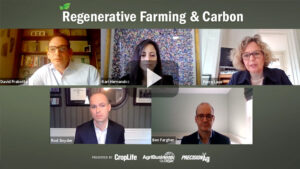Regenerative Farming and Carbon: 6 Key Takeaways From the Panel Discussion
On April 29, AgriBusiness Global hosted a live panel discussion, “Regenerative Farming and Carbon,” with nearly 1,000 registered attendees. Panelists, along with moderator, Editor David Frabotta, discussed how consumers are shaping production systems and why agribusinesses are making markets to pay farmers, meet consumer demand, and drive sustainable production. Here are the top takeaways from the event.
1. Work together to ensure transparency and integrity around sustainability commitments.

Ben Fargher
“We’re seeing recently the interest is growing, and you’re seeing the dynamic around markets including carbon markets growing almost exponentially,” said Ben Fargher, Managing Director of Sustainability, Cargill Agricultural Supply Chain, North America. “It makes sense for us an industry to work together when it comes to clarity around protocols, trust, and integrity in this endeavor, as we seek to make agriculture part of the solution to these global challenges, therefore giving our farmer-customers opportunities to build on the good work they’re doing.
“The nature of agriculture and the biological nature of the system in terms of sequestering carbon, how you measure it, how you account for it, and the protocols around the use of generating offsets and insets have been a real focus for us,” Fargher noted. “Is it changing our business? Absolutely, because we are seeking to do more with our farmer-customers to provide those solutions to that growing demand.”
2. Quality is everything when it comes to a carbon credit.

Kari Hernandez
“The reason is that a carbon credit is an intangible asset: It is only as valuable as the confidence that a buyer or market has in it. To achieve that confidence, there has to be trust, transparency, and consistency … I as a portfolio manager of that set of carbon offsets, need to make sure what I’m doing is actually having a measurable and understood impact on the environment, because that is what this is all about,” said Kari Hernandez, Vice President, Global Head of Carbon Operations & Offer Marketing, Indigo.
Indigo has worked with established standard-setting bodies in carbon credit markets outside agriculture to develop a methodology for agriculture around quantifying carbon credits. Hernandez described the three key concepts these bodies possess: 1) Realness. “Everything you measure or claim as part of a carbon credit has to be there.” 2) Additionality. “It has to be something new and incremental and something that wouldn’t otherwise have happened.” 3) Permanence. “This is particularly important and interesting in agriculture, because a buyer is not buying a temporary offset; they’re buying a permanent and sustained impact on atmospheric carbon.”
3. Regulatory action is unlikely to drive carbon farming in the U.S.

Rod Snyder
“If I look at ag policy in the U.S., there’s never been a huge appetite to use strong regulatory mechanisms with farmers. Voluntary, incentive-based approaches will likely continue in the future. Perhaps that will be different at a state level, but I think broadly speaking, we’re talking about a voluntary, incentive-based framework from the government,” Rod Snyder, President, Field to Market said.
He pointed to President Joe Biden’s reference, in his address to Congress on Apr. 28, of farmers planting cover crops, “so they can reduce carbon dioxide in the air and get paid for doing it” as a hat tip to the voluntary, incentive-based approach. “I think we’re going to see more of that kind of thing coming from Congress in this administration.”
4. The best way to change dietary habits and consumer demand? Make regeneratively grown food less expensive.

Petra Laux
“When we talk about incentives, I think it’s really important that we have public money building a market for nature, because nobody will pay for ecosystem services. You will not be able to raise private capital for this, so there must be a form of subsidization,” Petra Laux, Acting Chief Sustainability Officer with Syngenta Group in Basel, Switzerland offered. “While everybody wants to see positive (environmental change,) very few people are actually willing to pay for it. We can probably make steps toward this with labeling, but the best way to change dietary habits and consumer demand is by making regeneratively grown food the least expensive – not the most expensive.”
5. Ag must do a better job communicating information about carbon markets.
“I am encouraging commodity groups to really get active in this space – to set some principles around what needs to be managed pre-competitively and what type of education and guidance should we offer farmers,” Snyder said. “A very small number in the overall percentage of U.S. farmers are currently enrolled in these markets. There has been research on U.S. farmers in recent months indicating that two-thirds said the reason they’re not actively engaging is they just need more information.
“The industry has to do a better job around education and guidance and support, so farmers know exactly what the requirements are and what they’re signing up for. Global bodies have a role to play, but the agriculture sector itself needs to do a better job in supporting farmers to navigate this.”
 Now On Demand
Now On Demand
The “Regenerative Farming and Carbon” panel discussion presented by AgriBusiness Global is now available on demand.
Get access to this exclusive content here >>
6. Don’t let perfect get in the way of good.
“Give it a try, test on a couple of fields, and get in and start engaging with these programs,” Hernandez said. “The way we’re going to all figure this out is by learning and responding to what’s working and what’s not working. I think we’ll see that it is going to take us a few years to do that, and then we’ll all be set to take off. I think it’s a matter of just getting started.”





